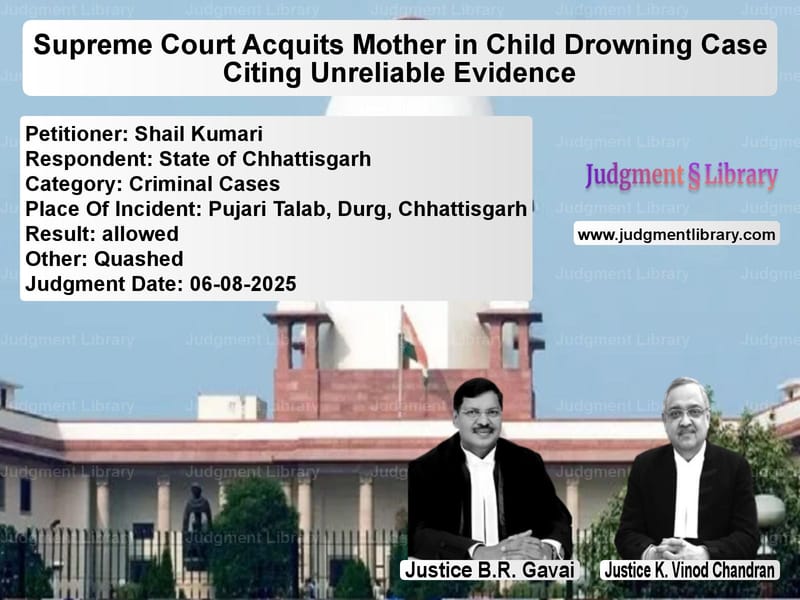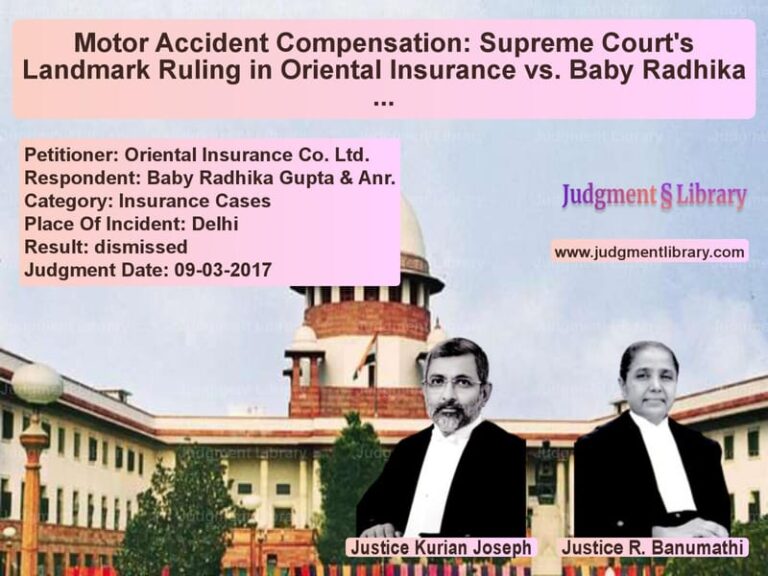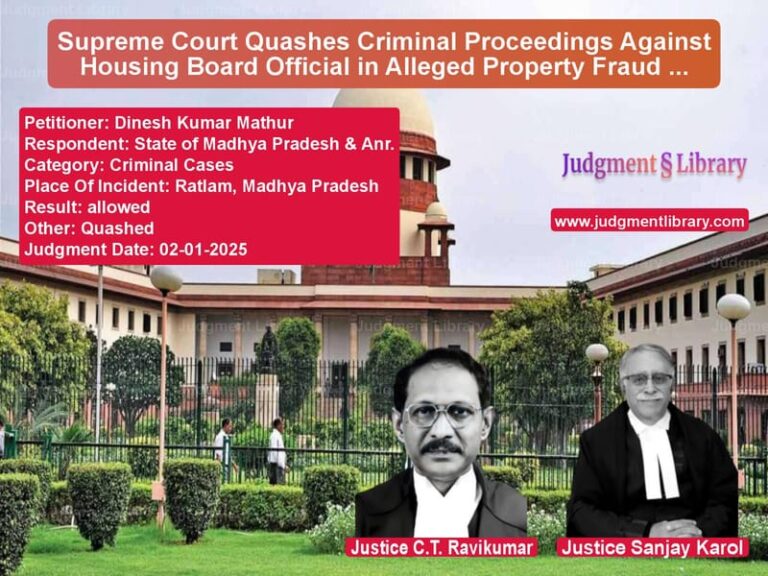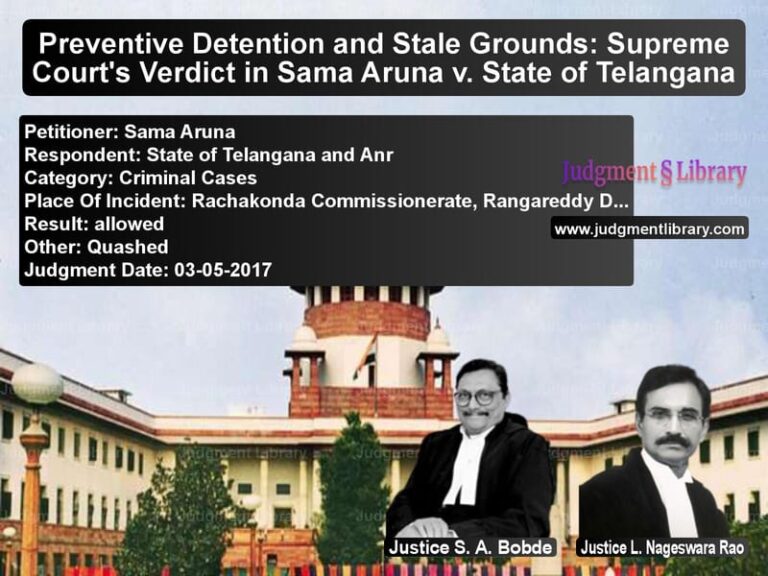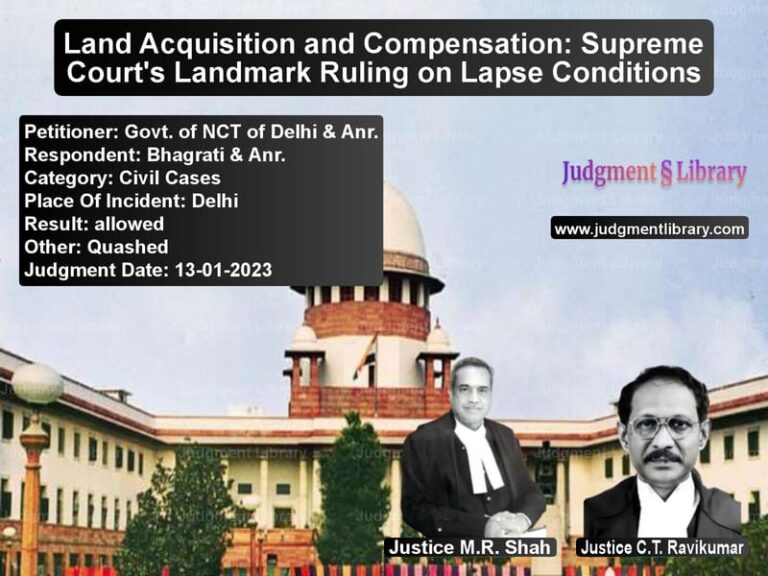Supreme Court Acquits Mother in Child Drowning Case Citing Unreliable Evidence
In a case that tugs at the heartstrings while testing the very foundations of criminal jurisprudence, the Supreme Court of India delivered a landmark judgment that underscores the critical importance of reliable evidence in criminal convictions. The case involved Shail Kumari, a mother accused of drowning her two young children in a water body in Chhattisgarh, whose conviction and life sentence were overturned by the highest court after years of legal battle.
The tragic incident dates back to October 11, 2003, when Santosh Kumar Pandey, owner of a Beetel Kiosk shop, noticed Shail Kumari walking toward Pujari Talab with her two children – a two-year-old son and four-month-old daughter. According to Pandey’s testimony, the appellant appeared to be in a “disordered condition,” which raised his suspicions. He asked a nearby rickshaw puller to follow her, and minutes later, the rickshaw puller returned with the horrifying news that two children were floating in the water body. Pandey then claimed to have seen Shail Kumari heading toward railway tracks, where he allegedly saved her from an approaching train. When questioned about why she killed her children, Pandey stated that Shail Kumari replied that “she had been fighting with her husband.”
The prosecution’s case relied heavily on this single witness account, leading to Shail Kumari’s conviction under Section 302 of the Indian Penal Code and a life sentence by the Trial Court, which was later affirmed by the Chhattisgarh High Court. However, the Supreme Court took a radically different view of the evidence, or rather, the lack thereof.
Read also: https://judgmentlibrary.com/supreme-court-reinstates-murder-conviction-in-bihar-fire-tragedy-case/
Before delving into the Supreme Court’s analysis, it’s crucial to understand the legal arguments presented by both sides. Smt. Nanita Sharma, learned counsel appearing for the appellant, made a compelling submission: “the present case is a case of no evidence. The High Court, only on the basis of conjectures and surmises, has convicted the appellant. It is, therefore, submitted that the present appeal deserves to be allowed and the appellant be acquitted of the charges.”
On the opposing side, Shri Prashant Singh, representing the State of Chhattisgarh, defended the lower courts’ decisions, arguing that “no perversity could be noticed in the concurrent findings of facts, so as to warrant interference of this Court. It is submitted that both the Courts below, upon correct appreciation of evidence, have found that it is the appellant alone who is responsible for committing the crime in question. It is, therefore, submitted that the appeal is liable to be dismissed.”
The Supreme Court’s judgment, authored by Chief Justice B.R. Gavai, fundamentally centered on the quality of evidence in criminal cases, particularly those relying on circumstantial evidence. The Court emphasized that “the present case rests on circumstantial evidence” and proceeded to elaborate on the established legal principles governing such cases.
In what became the cornerstone of their analysis, the Court extensively quoted from the landmark case of Sharad Birdhichand Sarda v. State of Maharashtra, which laid down what the Court described as “the panchsheel of the proof of a case based on circumstantial evidence.” The Court reproduced the crucial legal principles that must be fulfilled before convicting an accused based on circumstantial evidence:
“(1) the circumstances from which the conclusion of guilt is to be drawn should be fully established. It may be noted here that this Court indicated that the circumstances concerned ‘must or should’ and not ‘may be’ established. There is not only a grammatical but a legal distinction between ‘may be proved’ and ‘must be or should be proved’ as was held by this Court in Shivaji Sahabrao Bobade v. State of Maharashtra where the observations were made: ‘Certainly, it is a primary principle that the accused must be and not merely may be guilty before a court can convict and the mental distance between ‘may be’ and ‘must be’ is long and divides vague conjectures from sure conclusions.’
(2) the facts so established should be consistent only with the hypothesis of the guilt of the accused, that is to say, they should not be explainable on any other hypothesis except that the accused is guilty,
(3) the circumstances should be of a conclusive nature and tendency,
(4) they should exclude every possible hypothesis except the one to be proved, and
(5) there must be a chain of evidence so complete as not to leave any reasonable ground for the conclusion consistent with the innocence of the accused and must show that in all human probability the act must have been done by the accused.”
The Court further reinforced these principles by referencing the classic formulation from Hanumant v. State of Madhya Pradesh: “It is well to remember that in cases where the evidence is of a circumstantial nature, the circumstances from which the conclusion of guilt is to be drawn should in the first instance be fully established, and all the facts so established should be consistent only with the hypothesis of the guilt of the accused. Again, the circumstances should be of a conclusive nature and tendency and they should be such as to exclude every hypothesis but the one proposed to be proved. In other words, there must be a chain of evidence so far complete as not to leave any reasonable ground for a conclusion consistent with the innocence of the accused and it must be such as to show that within all human probability the act must have been done by the accused.”
Applying these stringent standards to the present case, the Supreme Court found the prosecution’s evidence severely lacking. The Court noted that “though the prosecution has examined nine witnesses, the conviction is based solely on the evidence of PW-2” – referring to Santosh Kumar Pandey. Upon careful examination of his testimony, the Court discovered critical flaws that undermined his credibility.
The judgment pointed out that “from the cross-examination of this witness, it would reveal that his statement in the examination-in-chief is a complete improvement than what was stated by him in his police statement. Whatever he narrated before the Court does not find place in his police statement.” This finding of “improvement” in testimony – where a witness adds details in court that weren’t mentioned in their original police statement – is often fatal to a witness’s credibility in criminal trials.
The Court further elaborated on witness reliability by referencing Vadivelu Thevar v. State of Madras, which classified witnesses into three categories: “(1) Wholly reliable. (2) Wholly unreliable. (3) Neither wholly reliable nor wholly unreliable.” The Court explained that “in the first category of proof, the court should have no difficulty in coming to its conclusion either way — it may convict or may acquit on the testimony of a single witness, if it is found to be above reproach or suspicion of interestedness, incompetence or subornation. In the second category, the court equally has no difficulty in coming to its conclusion. It is in the third category of cases, that the court has to be circumspect and has to look for corroboration in material particulars by reliable testimony, direct or circumstantial.”
Applying this classification to PW-2, the Court concluded that “the perusal of the cross-examination of PW-2 would reveal that he has fully improved his case in his examination-in-chief. He has narrated what does not find place in his statement under Section 161, Cr.P.C. As such, his evidence is totally contradictory and therefore totally unworthy.”
The Court also noted significant investigative lapses, observing that “the prosecution has not even examined the Rickshaw Fuller who was stated to have seen the appellant going towards the Pujari Talab and the children floating in the lake. The testimony of PW-2 being unreliable, at the most, can be treated as hearsay evidence.”
In their final analysis, the Supreme Court expressed grave concerns about the quality of evidence that had led to Shail Kumari’s conviction and life imprisonment. The Court stated unequivocally: “In that view of the matter, we are of the considered opinion that the conviction, as recorded by the Trial Court and affirmed by the High Court is totally based on conjectures and surmises. We are of the considered view that the conviction of the appellant is not sustainable in law at all.”
The judgment serves as a powerful reminder of fundamental legal principles: that the prosecution must prove its case beyond reasonable doubt, that evidence must be weighed for quality rather than quantity, and that in circumstantial evidence cases, the chain of circumstances must be so complete as to exclude every hypothesis of innocence. The Court’s meticulous examination of witness testimony and its insistence on adherence to established legal standards prevented what could have been a grave miscarriage of justice.
This case also highlights the human element in legal proceedings – a mother who had already suffered the unimaginable tragedy of losing both her children faced the additional ordeal of being wrongfully convicted for their deaths. The Supreme Court’s judgment not only restored her freedom but also reaffirmed the constitutional promise that every accused person is entitled to a fair trial based on reliable and credible evidence.
Petitioner Name: Shail Kumari.Respondent Name: State of Chhattisgarh.Judgment By: Justice B.R. Gavai, Justice K. Vinod Chandran.Place Of Incident: Pujari Talab, Durg, Chhattisgarh.Judgment Date: 06-08-2025.Result: allowed.
Don’t miss out on the full details! Download the complete judgment in PDF format below and gain valuable insights instantly!
Download Judgment: shail-kumari-vs-state-of-chhattisgar-supreme-court-of-india-judgment-dated-06-08-2025.pdf
Directly Download Judgment: Directly download this Judgment
See all petitions in Murder Cases
See all petitions in Bail and Anticipatory Bail
See all petitions in Fraud and Forgery
See all petitions in Custodial Deaths and Police Misconduct
See all petitions in Suicide Cases
See all petitions in Judgment by B R Gavai
See all petitions in Judgment by K. Vinod Chandran
See all petitions in allowed
See all petitions in Quashed
See all petitions in supreme court of India judgments August 2025
See all petitions in 2025 judgments
See all posts in Criminal Cases Category
See all allowed petitions in Criminal Cases Category
See all Dismissed petitions in Criminal Cases Category
See all partially allowed petitions in Criminal Cases Category

